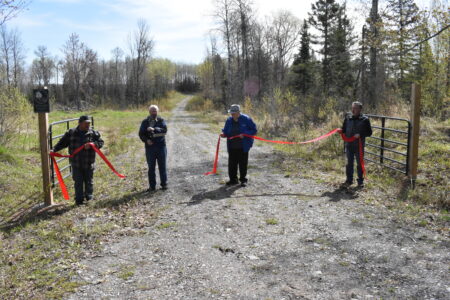The drive for efficiency relied on technology
By 1900, the efficiency and power of modern milling technology had reached a point that, in some instances, copper production was inhibited by the mine’s inability to supply sufficient rock to the mills. The Annual Report of the Copper Range Consolidated Company (CRCC) for 1902, stated that in the case of the Baltic Mining Company, organized in 1897, the most favorable condition for the lowest operating cost of the mine would be attained when the ability of the mine to supply the mill would equal the ability of the mill to handle the output of the mine.
At the Champion mine, which was organized in 1899, developments were different. The CRCC report of 1902 stated that while the Champion lode was of sufficient richness to supply 2,000 tons of rich amygdaloidal copper rock per day, the company leased one small stamp at the Atlantic mill, at Redridge, that stamped 120,485 tons of rock averaging more than 34 pounds of copper per ton of rock.
By April 1903, the Champion’s construction of its own mill at Freda, in Stanton Township, had progressed to the point where it had three steam-powered stamps in operation, with a fourth stamp to begin work by May 1. Already, the company was making plans to expand the mill to install two additional stamp heads, “which the mine will be abundantly able to supply before the installation can be completed.”
In the instance of the Baltic, the mine could not initially meet the capability of its mill. On the other hand, the Champion mine had conducted studies on the rock produced from opening the mine and made assessments of its product at the Atlantic mill. The results of the studies determined that to operate at peak production and cost efficiency, its mill would require a total of six stamps and designed their mill accordingly.
Modern technology was also placed right at the shafts. The 1902 Baltic report stated that a combined steel shaft-rockhouse were constructed at its No. 4 Shaft, which was “fitted with necessary rock breakers, (steam) hammers, etc.” The height of the building was 95 feet and contained rock bins with a capacity of 800 tons.
In a push to increase efficiency at the Quincy mine, in 1907, the lower working room of the No. 7 shaft-rockhouse was removed, three small rock breakers were replaced with two large 36-inch by 24-inch breakers, which were installed 10 feet higher than the ones they replaced, along with “entirely new system of handling the rock.” The changes and improvements increased the rock bin capacity from 150 tons to approximately 750 tons.
Quincy also reported that the timbers in the wooden No. 2 shaft-rockhouse had become so weakened by that shaft being up-cast that a new, steel and reinforced, fireproof, shaft-rockhouse had been ordered and would be constructed in 1908. The plans for the new structure showed the height would be 153 feet, and it was to be “a throughly modern structure along the most efficient lines of our practice.”
The Copper Range Company, along with the Quincy and the Calumet & Hecla companies, also possessed a railroad, the Copper Range Railroad Co., which contracted with the two mining companies to haul its rock and copper products, providing guaranteed and reliable transportation of all rock, coal, wood and supplies.
The Quincy & Torch Lake Railroad predated the CRRR by 12 years. Chartered in 1888, the line became operational in 1890. The railroad became necessary when the federal government ordered an end to all stamp mill operations on Portage Lake, compelling the company to erect a new mill on Torch Lake. Until then, the Quincy operated an incline tramway from the mine atop Quincy Hill to its mill on the shore of Portage Lake. The 6.5-mile Q&TL line ran between the mine location and the new mill, transporting mine rock to the mill and hauling coal from its storage facility near the mill, to the mine site.
Twenty years prior to the Q&TLRR was the Hecla & Torch Lake Railroad. Construction on the small railroad was begun in April 1867, while the Hecla Mining Company’s stamp mill was being built on Torch Lake.
In August of that year, Alexander Agassiz, president of both the Calumet and the Hecla mining companies, described the projects he was supervising at the mine locations, which included development “of both mines themselves, the perfecting of the Calumet Rock House, the changes in the Hecla mill at Torch Lake, and the construction, through a dense forest, of four and three-fifths miles of railroad with its connections to the various parts of the mines.”
As stated in the Calumet & Hecla Mining Co.: semi-centennial edition, 1866-1916, the original stamp mill for the Calumet mine was located near the mine site where, in 1867, Agassiz directed the building of a dam to serve the mill. But because the stream that fed the mill’s pond was not sufficient for the mill and the pond, he decided to locate the Hecla mine’s stamp mill on the shore of Torch Lake. The railroad, as originally built, transported Hecla’s rock to the head of an incline tram road, very similar to those used by the Quincy, Pewabic and the Franklin mines. By 1900, the road had been extended down the hill to the shore of Torch Lake, delivering rock to the Hecla mill, and to the newer mill built to handle the rock from the Calumet branch of the mine.
An article in the Calumet & Hecla Mining Co.: semi-centennial edition published in 1916, described the Hecla mill, which was started in 1867, and the Calumet mill, which operated its first head in 1872, as being typical of nearly every other concentrating plant in the copper region, with one exception. While rotating slime wheels had been in use since they were invented by William Evans at the Atlantic company’s mill, the semi-centennial publication stated that it was not until 1880 that C&H adopted the use of slime wheels at their mills.
C&H, like the other mining companies, would continue to rearrange, realign and introduce new technology, almost as quickly as it was patented. The challenge for the Lake Superior copper mines was that the copper-bearing lodes were different from any other mineral-producing ore bodies anywhere, and required unique processing.


